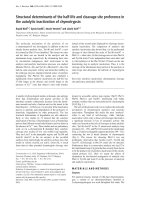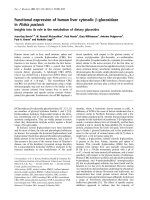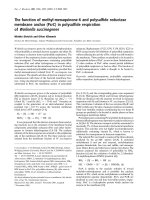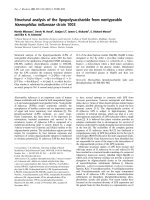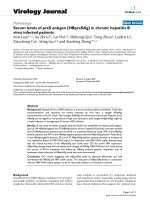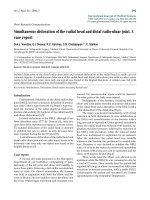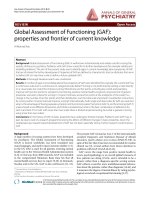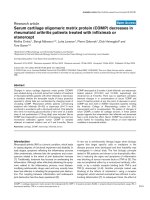Báo cáo y học: "Serum levels of matrix metalloproteinases -1,-2,-3 and -9 in thoracic aortic diseases and acute myocardial ischemia" potx
Bạn đang xem bản rút gọn của tài liệu. Xem và tải ngay bản đầy đủ của tài liệu tại đây (484.59 KB, 6 trang )
BioMed Central
Page 1 of 6
(page number not for citation purposes)
Journal of Cardiothoracic Surgery
Open Access
Research article
Serum levels of matrix metalloproteinases -1,-2,-3 and -9 in thoracic
aortic diseases and acute myocardial ischemia
Georgios T Karapanagiotidis*, Polychronis Antonitsis, Nicholas Charokopos,
Christophoros N Foroulis, Kyriakos Anastasiadis, Efthymia Rouska,
Helena Argiriadou, Kyriakos Rammos and Christos Papakonstantinou
Address: Department of Thoracic and Cardiovascular Surgery, AHEPA University Hospital, Thessaloniki, Greece
Email: Georgios T Karapanagiotidis* - ; Polychronis Antonitsis - ;
Nicholas Charokopos - ; Christophoros N Foroulis - ;
Kyriakos Anastasiadis - ; Efthymia Rouska - ;
Helena Argiriadou - ; Kyriakos Rammos - ;
Christos Papakonstantinou -
* Corresponding author
Abstract
Background: Matrix metalloproteinases (MMPs) constitute a family of zinc-dependent proteases
(endopeptidases) whose catalytic action is the degradation of the extracellular matrix components. In
addition, they play the major role in the degradation of collagen and in the process of tissue remodeling.
The present clinical study investigated blood serum levels of metalloproteinases- 1, -2, -3 and -9 in patients
with acute and chronic aortic dissection, thoracic aortic aneurysm and acute myocardial ischemia
compared to healthy individuals.
Methods: The blood serum levels of MMP-1, -2, -3 and -9 were calculated in 31 patients with acute aortic
dissection, 18 patients with chronic aortic dissection, 18 patients with aortic aneurysm and in 13 patients
with acute myocardial ischemia, as well as in 15 healthy individuals who served as the control group. Serum
MMP levels were measured by using an ELISA technique.
Results: There were significantly higher levels of MMP-3 in patients with acute myocardial ischemia as
compared to acute aortic dissection (17.33 ± 2.03 ng/ml versus 12.92 ± 1.01 ng/ml, p < 0.05). Significantly
lower levels of MMP-1 were found in healthy controls compared to all groups of patients (1.1 ± 0.38 ng/
ml versus 2.97 ± 0.68 in acute aortic dissection, 3.09 ± 0.98 in chronic dissection, 3.16 ± 0.51 in thoracic
aortic aneurysm and 4.58 ± 1.04 in acute myocardial ischemia, p < 0.05). Higher levels of MMP-1 and MMP-
3 were detected on males. There was a positive correlation with increasing age (r = 0.38, p < 0.05). In
patients operated for acute type A aortic dissection, the levels of MMP-1, MMP-3 and MMP-9 increased
immediately after surgery, while the levels of MMP-2 decrease. At 24 hours postoperatively, levels of MMP
-1, -2 and -9 are almost equal to the preoperative ones.
Conclusion: Measurement of serum MMP levels in thoracic aortic disease and acute myocardial ischemia
is a simple and relatively rapid laboratory test that could be used as a biochemical indicator of aortic
disease or acute myocardial ischemia, when evaluated in combination with imaging techniques.
Published: 3 November 2009
Journal of Cardiothoracic Surgery 2009, 4:59 doi:10.1186/1749-8090-4-59
Received: 25 July 2009
Accepted: 3 November 2009
This article is available from: />© 2009 Karapanagiotidis et al; licensee BioMed Central Ltd.
This is an Open Access article distributed under the terms of the Creative Commons Attribution License ( />),
which permits unrestricted use, distribution, and reproduction in any medium, provided the original work is properly cited.
Journal of Cardiothoracic Surgery 2009, 4:59 />Page 2 of 6
(page number not for citation purposes)
Background
Matrix metalloproteinases (MMPs) constitute a large fam-
ily of proteolytic enzymes containing a metal in their
organic structure playing key roles in degradation of pro-
teins in extracellular matrix and in tissue remodeling
through complicated biological procedures [1-3]. This
double action has been proven to be involved in the
pathology of serious cardiovascular diseases, such as aor-
tic aneurysm, dissection and coronary artery disease,
which constitute the most common cause of death in
developed countries [4-6].
In all the above pathological processes, but mostly in
acute aortic dissection, a complex process is initiated for
the repair and remodeling of the involved aortic wall. This
process includes thrombus degradation through fibrino-
lytic activity and proteolysis of the extracellular matrix [7-
9]. MMPs are proteolytic enzymes, specifically endopepti-
dases, whose catalytic mechanism involves a metal ion
such as zinc (Zn
2+
) and calcium (Ca
2+
) [10]. Metallopro-
teinases, also called matrixins, include a large family of
proteolytic enzymes, known as metzincin super-family.
Their catalytic action is the degradation, mainly in neutral
pH environment, of all proteins of the extracellular matrix
[11]. In addition, they modulate many bioactive mole-
cules at the cell surface and can act in concept to influence
cell behaviour such as angiogenesis, migration, reproduc-
tion and immune system activity [12].
A number of metalloproteinases have been identified in
blood serum that are categorized mainly in four groups: a)
collagenases (MMP-1, MMP-8, MMP-13, MMP-18), b)
gelatinases (MMP-2, MMP-9) c) stromelysins (MMP-3,
MMP-10) and d) membrane-bound metalloproteinases
(MMP-14, MMP-15, MMP-16, MMP-17, MMP-24, MMP-
25) [13].
The aim of our study is to evaluate the levels of serum
MMP-1, -2, -3 and -9 in acute and chronic aortic dissec-
tion, thoracic aortic aneurysm and acute myocardial
ischemia compared to normal individuals and assess their
clinical significance.
Methods
A total of 80 consecutive patients managed in a single
institution were prospectively included in the study over a
period of two years. Patients were classified according to
the underlying disease process in four groups: Group A
consisted of 31 patients with acute aortic dissection,
group B consisted of 18 patients with chronic aortic dis-
section, group C included 18 patients with thoracic aortic
aneurysm and group D included 13 patients with acute
coronary syndrome presenting with electrocardiographic
changes indicative of myocardial ischemia with or with-
out elevation of myocardial enzymes. Control group
(Group E) consisted of 15 healthy individuals. Demo-
graphic data of the study population are presented in
Table 1.
Exclusion criteria included the presence of abdominal
aortic aneurysm, use of corticosteroid or non-steroid anti-
inflammatory medication, or a history of chronic pulmo-
nary disease or malignancy of any type. All these clinical
conditions have been associated with elevated levels of
serum MMPs [5,11].
The following MMPs were measured in the blood serum
of all individuals: MMP-1 (interstitial collagenase) as rep-
resentative of collagenases, MMP-3 (stromelysin 1) as rep-
resentative of stromelysins, MMP-2 (gelatinase A) and
MMP-9 (gelatinase B) as representatives of gelatinases.
Blood samples in group A were collected after diagnosis of
acute aortic dissection was established mainly with com-
puted tomography angiography and before any surgical
intervention in case of Stanford A dissection. Seventeen
patients in this group (50%), who were diagnosed with a
Stanford A dissection, were operated for aortic root
replacement. In these patients serial MMP serum levels
were also calculated just after transfer of the patient from
theater to ICU and at 12 and 24 hours postoperatively.
Table 1: Demographic characteristics of the study groups
Characteristic Group A
(n = 31)
Group B
(n = 18)
Group C
(n = 18)
Group D
(n = 13)
Group E
(n = 15)
Age mean ± SD 60.1 ± 14.8 60.6 ± 13.1 60.7 ± 13.7 65.4 ± 10.3 40.1 ± 5.2
Male/Female 26/8 17/1 14/4 13/0 3/12
Arterial hypertension (%) 22 (64.7%) 13 (72.2%) 15 (83.3%) 12 (92.3%) 0
Diabetes (%) 13 (38.2%) 3 (16.6%) 2 (11.1%) 4 (30.7%) 0
CAD (%) 11 (32.3%) 2 (11.1%) 8 (44.4%) 13 (100%) 0
Hyperlipidemia (%) 9 (26.4%) 7 (38.8%) 10 (55.5%) 9 (69.2%) 0
Chest pain (%) 33(97%) 0 1 (5.5%) 13 (100%) 0
ST-elevation (%) 6 (17.6%) 0 0 13 (100%) 0
Creatinine > 140 μmol/l (%) 8 (23.5%) 3 (16.6%) 2 (11.1) 2 (15.3%) 0
CAD: Coronary Artery Disease
Journal of Cardiothoracic Surgery 2009, 4:59 />Page 3 of 6
(page number not for citation purposes)
Blood samples in groups B and C were collected before
any surgical intervention (open or endovascular). Blood
samples in group D were collected at the onset of acute
thoracic pain.
All blood samples were collected through a central venous
or peripheral catheter and centrifuged at 4,000 rpm. Then,
the centrifuged serum samples were refrigerated at -27°C
and stored until final analysis. Serum MMP levels were
measured by using a quantitative sandwich enzyme-
linked immunosorbent assay (ELISA) test (R&D Systems
Europe, Abingdon, UK) according to the manufacturer's
guidelines. All samples were measured as duplicates. The
mean was calculated for data analysis. The levels of MMPs
were determined according to a known curve which takes
into account four parameters based on the following
equation: 4 parameter- (y = (A-D)/(1+(x/C)^B)+D) and
the use of 7 values as standards for the calculation of the
standard curve. All MMPs values were measured as ng/ml.
Statistical analysis
All data are presented as mean ± standard error. Quantita-
tive variables were tested for normality of their distribu-
tion by the Kolmogorov-Smirnov test. For non-parametric
quantitative variables, data were subjected to Kruskal-
Wallis analysis and tested with Mann-Whitney U test,
while for qualitative variables the chi-square test was
used. The Spearman's test was used for regression analysis.
Analyses were performed using the SPSS statistical pack-
age (version 11.5 for Windows). Differences were consid-
ered significant if p values were lower than 0.05.
Results
The mean values of the four studied metalloproteinases
(MMP-1, MMP-2, MMP-3, MMP-9) in each group are pre-
sented in Table 2. It was observed that levels of MMP-1
and MMP-3 in all groups of patients were significantly
higher (p < 0.05) in men compared to those found in
women (Table 3). In addition, levels of MMP-1 showed a
statistically significant positive correlation with age (Pear-
son correlation coefficient r = 0.38, p < 0.01, Figure 1).
Mean values of MMP-1 were lower in healthy individuals
(group E) and higher in patients with acute myocardial
ischemia (group D). Mean values of MMP-2 were lower in
patients with acute aortic dissection (group A) and higher
in patients with acute myocardial ischemia (group D).
Mean values of MMP-3 were lower in the control group
(group E) and higher in patients with thoracic aortic aneu-
rysm (group C). As far as the mean values of MMP-9 are
Table 2: The levels of metalloproteinases (ng/ml) in studied groups of patients and healthy individuals
MMPs Disease No. patients Mean value ± St. error
(ng/ml)
MMP-1 Acute aortic dissection 31 2.97 ± 0.68
Chronic aortic dissection 18 3.09 ± 0.98
Aneurysm 18 3.16 ± 0.51
Myocardial ischemia 13 4.58 ± 1.04
Healthy individuals 15 1.10 ± 0.38
Total 95 2.95 ± 0.34
MMP-2 Acute aortic dissection 31 151.62 ± 6.82
Chronic aortic dissection 18 172.12 ± 11.79
Aneurysm 18 156.64 ± 9.16
Myocardial ischemia 13 180.94 ± 15.49
Healthy individuals 15 171.37 ± 11.39
Total 95 163.59 ± 4.58
MMP-3 Acute aortic dissection 31 12.92 ± 1.01
Chronic aortic dissection 18 17.50 ± 3.60
Aneurysm 18 17.64 ± 3.64
Myocardial ischemia 13 17.33 ± 2.03
Healthy individuals 15 10.66 ± 1.77
Total 95 14.93 ± 1.11
MMP-9 Acute aortic dissection 31 412.93 ± 89.85
Chronic aortic dissection 18 469.86 ± 56.57
Aneurysm 18 342.97 ± 74.66
Myocardial ischemia 13 409.74 ± 83.35
Healthy individuals 15 400.13 ± 77.90
Total 95 408.00 ± 37.78
Journal of Cardiothoracic Surgery 2009, 4:59 />Page 4 of 6
(page number not for citation purposes)
concerned, these were higher in patients with chronic aor-
tic dissection (group B) and lower in patients with tho-
racic aortic aneurysm (group C) (Figure 2A, B).
MMP-1 serum levels in healthy individuals (group E) were
significantly lower when compared to those observed in
all other groups (p < 0.05). MMP-3 serum levels in
healthy individuals (group E) were also found to be lower
compared to the other groups, however this difference did
not reach statistical significance. As far as the levels of
MMP-2 and MMP-9 are concerned, serum levels were sim-
ilar between groups.
Furthermore, blood serum levels of MMP-3 in patients
with acute aortic dissection were significantly lower com-
pared to those found in patients with acute myocardial
ischemia (12.92 ± 1.10 versus 17.33 ± 2.03 ng/ml, p <
0.05). Mean values of MMP-1, MMP-2 and MMP-9 did
not show significant difference between groups A and D.
In addition, levels of MMP-1, -2, -3, -9 were not statisti-
cally different in patients with chronic aortic dissection
(group B), aortic aneurysm (group C) and healthy indi-
viduals (group E).
Mean values of all MMPs showed a characteristic pattern
of change in patients operated for acute type A aortic dis-
section. (Table 4). More specifically, the levels of MMP-1
increased immediately after the operation and decreased
gradually at 12 and 24 hours thereafter. Levels of MMP-2
gradually decreased after the intervention and 12 hours
afterwards, however they showed an increase at 24 hours
postoperatively. Levels of MMP-3 were slightly increased
after surgical intervention, while a more pronounced
increase was observed at 12 and 24 hours after the inter-
vention. Finally, levels of MMP-9 showed a peak immedi-
ately after the operation, while they decreased at 12 hours
and then slightly increased at 24 hours.
Discussion
Matrix metalloproteinases play a significant role in the
pathogenesis of aortic disease. The present study evalu-
ated the levels of serum MMPs- 1, -2, -3 and -9 in patients
with diseases of the thoracic aorta. These were compared
with values obtained from patients with acute myocardial
ischemia and from normal individuals.
The levels of MMP-1 were found to be lower in healthy
individuals compared to patients with acute and chronic
aortic dissection, aortic aneurysm and myocardial
ischemia. Atherosclerosis is the main common pathologic
finding in these disorders. Clinical studies have investi-
gated the role of MMP-1 in this pathologic process
[6,14,15]. These studies evaluated the levels of MMP-1 in
the vessel's wall and not in blood serum as performed in
the present study.
Kai et al. measured the levels of MMPs-2 and -9 in the
blood serum of patients with acute myocardial ischemia
and they revealed a significant increase compared to
healthy individuals [16]. This is in contradiction with the
results of the present study. Nambi et al. investigated the
levels of MMP-1 in patients with coronary artery disease
[17]. They have not found any difference and concluded
that MMP-1 can not be used as a prognostic biomarker for
coronary artery disease. On the contrary, we observed that
mean values of MMP-1 in patients with acute myocardial
ischemia were significantly higher compared to the con-
trol group. This difference can be attributed to the fact that
patients in our study suffered from acute myocardial
Table 3: Comparison of the levels (ng/ml) of metalloproteinases in all groups according to sex
Metalloproteinase Sex of patient No. patients Mean value ± St. error
(ng/ml)
p-value
MMP-1 (ng/ml) Men 70 3.44 ± 0.45 0.049
Women 25 1.60 ± 0.29
MMP-2 (ng/ml) Men 70 165.60 ± 55.64 0.478
Women 25 157.80 ± 17.38
MMP-3 (ng/ml) Men 70 17.40 ± 1.38 0.000
Women 25 8.03 ± 0.58
MMP-9 (ng/ml) Men 70 437.53 ± 47.40 0.193
Women 25 325.33 ± 52.69
Correlation of MMP-1 levels with increasing ageFigure 1
Correlation of MMP-1 levels with increasing age.
Journal of Cardiothoracic Surgery 2009, 4:59 />Page 5 of 6
(page number not for citation purposes)
ischemia, and not chronic stable coronary artery disease.
In addition, healthy individuals in the present study were
of younger age which may have affected their MMP-1 lev-
els.
MMP-1 levels in our study showed a positive correlation
with age, a finding that has not been previously reported
in the literature. In addition, the levels of MMP-1 were
found to be significantly higher in men compared to
women in all study groups. To the best of our knowledge,
gender variability of MMP-1 has not been previously
investigated in the literature.
As far as MMP-3 is concerned, it was found that the MMP-
3 levels in patients with acute myocardial ischemia were
significantly higher than those found in patients with
acute aortic dissection. In many occasions patients with
acute aortic dissection present with clinical and electrocar-
diographic signs that mimic myocardial ischemia, which
make differential diagnosis difficult [18]. Numerous stud-
ies have reported high levels of MMP-3 in atherosclerotic
plaques in any kind of aortic aneurysm [15,19,20]. High
levels of MMP-3 have also been reported in the blood
serum of patients with coronary arteries aneurysm [21].
MMP-3, as well as MMP-9, has been implicated in the
pathogenesis and treatment of abdominal aortic aneu-
rysms [22,23]. In a recent study by Monaco et al. it was
found that the levels of MMP-3 in the blood serum
decreased after endovascular repair of descending thoracic
aortic aneurysms [24]. In addition, our study found that
MMP-3, as also shown with MMP-1 levels, is increased in
the blood serum of men compared to women in all
groups.
The present study also investigated the pattern of change
in the levels of the four metalloproteinases after surgical
intervention in patients operated for acute aortic dissec-
tion. It was found that, immediately after the interven-
tion, the levels of MMP-1, MMP-3 and MMP-9 are
increased, while the levels of MMP-2 are decreased. At 24
hours postoperatively, levels of MMP -1, -2 and -9 are
almost equal to the preoperative ones. Sangiorgi et al.
found that after endovascular exclusion MMP-9 and
MMP-3 levels decreased to a level similar to that of
patients undergoing open repair [25]. The cardiopulmo-
nary bypass has also been reported to affect serum levels
of MMPs [26]. Therefore, duration of extracorporeal circu-
lation is a factor that has to be considered when studying
the levels of MMPs after surgical intervention.
As a conclusion, measurement of serum MMP levels in
thoracic aortic disease and acute myocardial ischemia is a
simple and relatively rapid laboratory test, which can be
easily obtained even in the primary healthcare setting.
A. Mean values of MMP-1 and -3 B. Mean values of MMP -2, and -9 in all study groupsFigure 2
A. Mean values of MMP-1 and -3 B. Mean values of MMP -2, and -9 in all study groups.
Table 4: Variability in acute aortic dissection of the levels (ng/ml) of metalloproteinases before the surgical intervention, immediately
after, at 12 and 24 hours after the intervention
Metalloproteinase Before surgical intervention Immediately after 12 hours post-op 24 hours post-op p-value
MMP-1 (ng/ml) 3.73 ± 0.90 8.92 ± 3.92 6.62 ± 1.52 3.38 ± 1.25 0.010
MMP-2 (ng/ml) 152.61 ± 9.92 132.72 ± 5.18 117.23 ± 7.14 134.02 ± 8.06 0.015
MMP-3 (ng/ml) 12.39 ± 1.34 13.52 ± 1.14 23.71 ± 4.46 29.50 ± 6.25 0.00004
MMP-9 (ng/ml) 408.16 ± 142.57 616.65 ± 70.35 120.96 ± 19.15 123.36 ± 33.93 0.00001
Values represent means ± St. error
Journal of Cardiothoracic Surgery 2009, 4:59 />Page 6 of 6
(page number not for citation purposes)
Although increased MMP-1 and -3 levels are not specific
and can not provide a definite clinical diagnosis, they can
be used as a biochemical indicator of aortic disease or
acute myocardial ischemia, when evaluated in combina-
tion with imaging techniques, such as computed tomog-
raphy, magnetic resonance angiography or
echocardiography. The concept of biochemical diagnosis
of aortic dissection is an attractive option, as it is rapid,
non-invasive, easy to perform and conceivably less costly
than contemporary imaging studies. Further studies are
required in order to draw precise conclusions on the clin-
ical significance of MMP serum levels in diagnosis and
monitoring of different therapeutic strategies in the man-
agement of cardiovascular diseases.
Competing interests
The authors declare that they have no competing interests.
Authors' contributions
GK carried out the design of the study, patient selection,
collection of samples, performed analysis of the results
and drafted the manuscript, PA performed the statistical
analysis and drafted the manuscript, NC conceived of the
study and participated in its design and coordination, CF
contributed to the statistical analysis and drafted the man-
uscript, KA participated in patient selection and in study
design and drafted the manuscript, ER contributed to
patient selection and study design, HA participated in
patient management and study design, KR and CP con-
ceived of the study and participated in its design and coor-
dination.
Acknowledgements
Dr Christina Aggouridaki, Vassiliki Tsavdaridou and Constantinos Tomos
performed the ELISA biochemical analysis. Dr Ioannis Karapanagiotidis con-
tributed to the statistical analysis of the results.
References
1. Birkedal-Hansen H, Moore WGI, Bodden MK, Windsor LJ, Birkedal-
Hansen B, DeCarlo A, Engler JA: Matrix metalloproteinases: a
review. Crit Rev Oral Biol Med 1993, 4:197-250.
2. Galis ZS and Khatri JJ: Matrix metalloproteinases in vascular
remodelling and atherogenesis: The good, the bad, and the
ugly. Circulation Research 2002, 90:251-62.
3. Visse R, Nagase H: Matrix metalloproteinases and tissue inhib-
itors of metalloproteinases: Structure, function, and bio-
chemistry. Circ Res 2003, 92:827-839.
4. Isselbacher EM: Thoracic and abdominal aortic aneyrysms. Cir-
culation 2005, 111:816-828.
5. Dollery CM, McEwan JR, Henney A: Matrix metalloproteinases
and cardiovascular disease. Circ Res 1995, 7:863-8.
6. Galis ZS, Sukhova GK, Lark MW, Libby P: Increased expression of
matrix metalloproteinases and matrix degrade activity in
vulnerable regions of human atherosclerotic plaques. J Clin
Invest 1994, 94:2493-503.
7. Hojo Y, Ikeda U, Ueno S, Arakawa H, Shimada K: Expression of
matrix metalloproteinases in patients with acute myocardial
infarction. Jpn Circ J 2001, 65:71-75.
8. Toshiharu I, Noriko A: Collagen and elastin degradation by
matrix metalloproteinase in aortic dissection. Hum Pathol
2000, 31:640-646.
9. Lijnen HR: Metalloproteinases in development and progres-
sion of vascular disease. Pathophysiol Haemost Thromb 2004,
33:275-281.
10. Woessner JF Jr: Matrix metalloproteinases inhibition: from the
Jurassic to the third millennium. Ann NY Acad Sci 1999, 878:388.
11. Nagase H, Woessner JF Jr: Matrix metalloproteinases. J Biol Chem
1999,
274:21491-94.
12. Matrisian LM: The matrix degrading metalloproteinases. Bioes-
says 1992, 14:455-463.
13. Murphy G, Nagase H: Progress in matrix metalloproteinases
research. Mol Asp Med 2008, 29:290-308.
14. Montero I, Orbe J, Varo N, Beloqui O, Monreal JI, Rodríguez JA, Díez
J, Libby P, Páramo JA: C-reactive protein induces matrix metal-
loproteinase-1 and -10 in human endothelial cells: implica-
tions for clinical and subclinical atherosclerosis. J Am Coll
Cardiol 2006, 47:1369-78.
15. Orbe J, Fernandez L, Rodriguez JI, Rabago G: Different expressions
of MMPs/TIMP-1 in human atherosclerotic lesions. Relation
to plaque features and vascular bed. Atherosclerosis 2003,
170:269-76.
16. Kai H, Ikeda H, Yasukawa H, Kai M, Seki Y, Kuwahara F, Ueno T, Sugi
K, Imaizumi T: Peripheral blood levels of matrix metalloprotei-
nases-2 and -9 are elevated in patients with acute coronary
syndromes. J Am Coll Cardiol 1998, 32:368-72.
17. Nambi V, Morrison A, Hoogeveen RC, Coresh J, Miles S, Rhodes CE,
Sharrett AR, Boerwinkle BE, Ballantyne CM: Matrix metalloprotei-
nase-1 and tissue inhibitors do not predict incident coronary
artery disease. Tex Heart Inst J 2008, 35:388-94.
18. Mir MA: Aortic dissection - in pursuit of a serum marker. Am
J Emerg Med 2008, 26:942-45.
19. Newman KM, Ogata Y, Malon AM, Irizarry E, Gandhi RH, Nagase H,
Tilson MD: Identification of matrix metalloproteinases-3 and
-9 in abdominal aneurysm. Arterioscler Thromb 1994, 14:1315-8.
20. Carrell TW, Burnard KG, Wells GM, Clements JM, Smith A:
Stromelysin-1 (matrix metalloproteinase-3) and tissue
inhibitor of metalloproteinase-3 are overexpressed in the
wall of abdominal aortic aneurysms. Circulation 2002,
105:477-82.
21. Tengiz I, Ercan E, Aliyev E, Sekuri C, Duman C, Altuglu I: Elevated
levels of matrix metalloproteinase-3 in patients with coro-
nary aneurysm: A case control study. Cur Contr Tr Cardiovasc
Med 2004, 5:1-10.
22. Keeling WB, Armstrong PA, Stone P, Bandyk DF, Shames ML: An
overview of matrix metalloproteinases in the pathogenesis
and treatment of abdominal aortic aneurysms. Vasc Endovasc
Surg 2005, 39:457-64.
23. Sangiorgi G, D'Averio R, Mauriello A, Bondio M, Pontillo M, Cas-
telvecchio S, Trimarchi S, Tolva T, Nano G, Rampoldi V, Spagnoli LG,
Inglese L: Plasma levels of metalloproteinases-3 and -9 as
markers of successful abdominal aortic aneurysm exclusion
after endovascular graft treatment. Circulation 2001, 104(suppl
1):288-295.
24. Monaco M, Stassano P, DiTomasso L, Iannelli G: Response of
plasma matrix metalloproteinases and tissue inhibitor of
metalloproteinases to stent-graft surgery for descending
thoracic aortic aneurysms. J Thorac Cardiovasc Surg 2007,
134:925-31.
25. Sangiorgi G, Trimarchi S, Mauriello A, Righini P, Bossone E, Suzuki T,
Rampoldi V, Eagle KA: Plasma levels of metalloproteinases-9
and -2 in the acute and subacute phases of type A and type B
aortic dissection. J Cardiovasc Med 2006, 7:307-315.
26. Joffs C, Gunasinghe HR, Multani MM, Dorman BH, Kratz JM, Crumb-
ley AJ, Crawford FA Jr, Spinale FG: Cardiopulmonary bypass
induces the synthesis and release of matrix metalloprotein-
ases. Ann Thorac Surg 2001, 71:1518-23.

